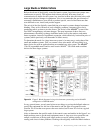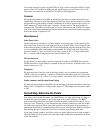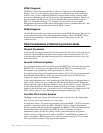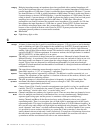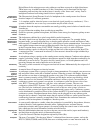
Glossary129
C
HAPTER
0
C
HAPTER
0
C
HAPTER
0
C
HAPTER
0
G
LOSSARY
A
Acoustics
The science of sound.
Acoustical
A term used to differentiate a sound signal from its electrical signal counterpart or representation.
For example: A microphone converts an acoustical signal (from music or speech) to an electrical
signal. A loudspeaker converts an electrical signal to an acoustical signal.
Active Devices
Devices requiring operating power (battery or other) in addition to the signal. Examples are
transistors, integrated circuits, amplifiers, and intercoms.
AF
Audio Frequency. Within the range of 20 hertz to 20,000 hertz.
AGC
Automatic Gain Control.
All Call
For talk key assignment only. Activating an All Call key will also activate all talk keys to the left
of the All Call key (up to, but not including another All Call key).
Alpha
Alphas are the user-changeable names which identify destinations (intercom ports, Party-Lines,
etc.). Change Alpha names for intercom ports using the Port Alpha button in AZ™EDIT Change
Alpha names for everything else using the Other Alpha button. When you assign a destination to
a talk key, the alpha name will appear in the alphanumeric display for that key (on keypanels so
equipped).
AM
Amplitude Modulation.
Ambient
Conditions existing at a location. Example: ambient temperature.
Ambience
Background noise or sounds.
Ampere
The amount of electrical current when one volt is applied to one ohm. Also equal to one coulomb
of electrical charge passing a point in one second.
Amplitude
The size of analog electrical signal as opposed to its frequency or other parameters. Magnitude
also indicates a size. Amplitudes focus more from the measurement viewpoint, for example: a one
volt peak sine wave amplitude, a one volt average amplitude.
Amplifier
Usually an electronic device that increases the amplitude of an electrical signal. Examples include
a microphone preamplifier that brings millivolt signals to volt levels. A power amplifier that
makes a one milliwatt signal into a 10, 100, 1000, or more watt signal.
Analog vs.
Digital
Analog (as opposed to digital) here refers to the way information is put onto an electrical signal.
An analog signal varies in voltage or current in step with the signal it represents. In the case of the
acoustic pressure wave from speech, the pressure wave is converted to an electrical signal by a
microphone. The voltage from the microphone varies as the sound pressure from the acoustic
wave. A digital electrical signal either represents a binary number 0 or binary number 1.
Combinations of numbers represent the amplitude of the pressure wave. The pressure wave is
sampled at a rate two or more times the highest frequency to be transmitted. Therefore, there are a
sequence of digital numbers representing the speech over a period of time. The advantage of
analog circuitry is that it is conceptually simple and relatively easy to create. The disadvantage of
analog circuitry is that it is sensitive to distortion and the quality of the circuit design and





